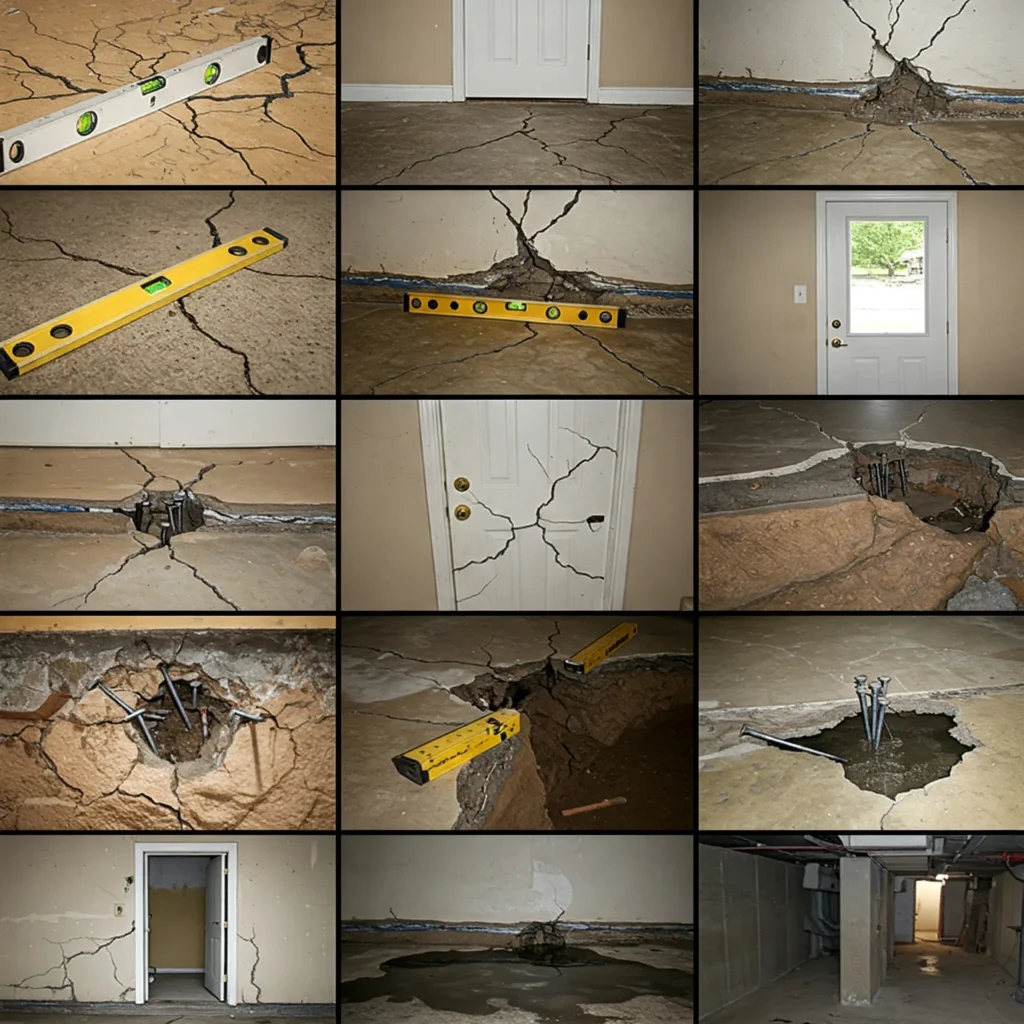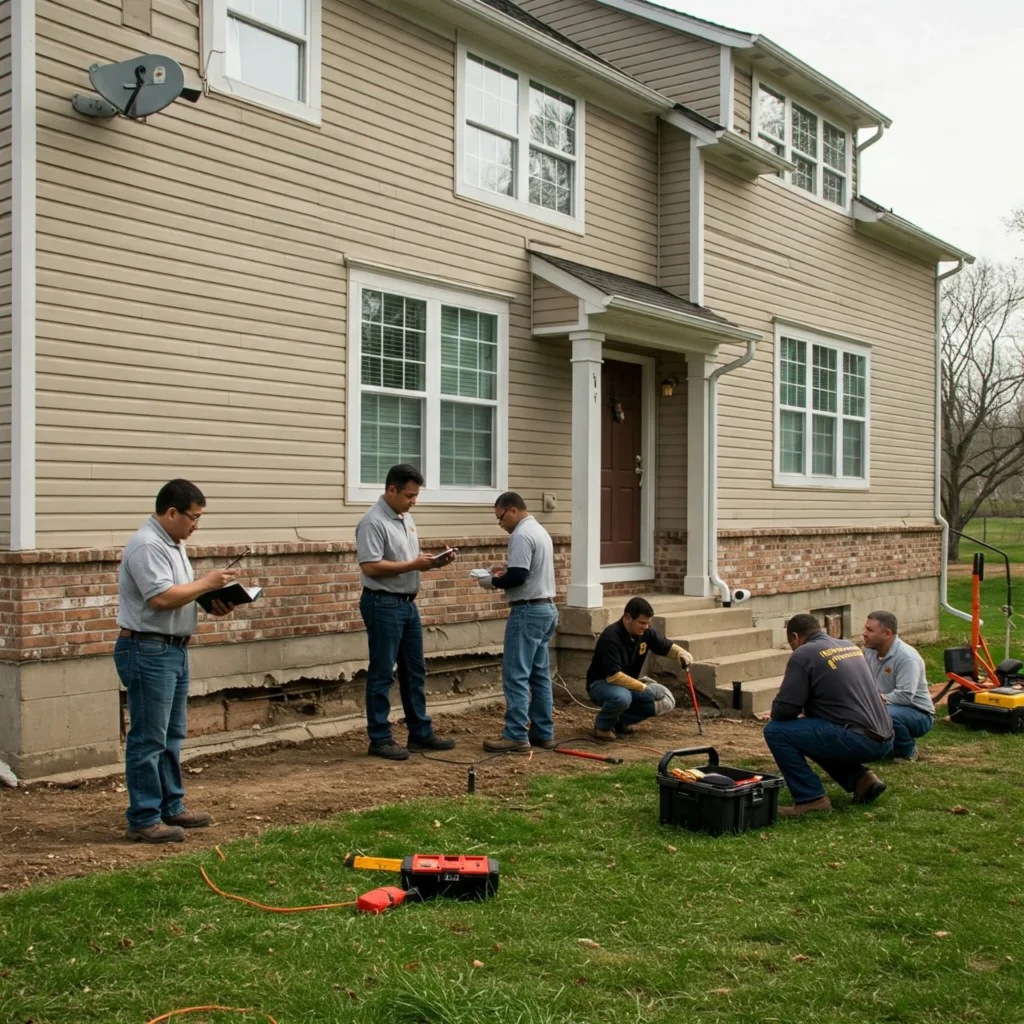If you’ve noticed cracks in your walls or doors that don’t close quite right, you might be wondering is my foundation in trouble? Foundation problems can sneak up on homeowners, and ignoring the signs can lead to costly repairs down the road. The good news? Catching the early warning signs can save you time, money, and stress.
In this post, we’ll walk you through the top 9 signs of foundation issues, what they might mean, and how to respond before things get worse.
You might like: Foundation Crack Repair: The Ultimate Step-by-Step Guide
What Causes Foundation Problems?
Before diving into the warning signs, it helps to understand what causes foundation problems in the first place.
Common causes include:
Soil movement or poor soil compaction
Excess moisture or drought conditions
Poor drainage around your home
Plumbing leaks under the slab
Tree roots growing too close to the foundation
Understanding these factors can help you prevent problems in the future.

9 Warning Signs of Foundation Problems
1. Cracks in Walls or Ceilings
Cracks in your interior walls or ceilings can be an early sign of foundation movement. These are usually seen around doors, windows, or corners of rooms. Small hairline cracks may be cosmetic, but wider cracks, especially those forming in a zig-zag or stair-step pattern, can signal structural shifts in your home’s foundation. Cracks that keep growing or reappear after patching should not be ignored. They often indicate that the foundation is settling unevenly or pulling apart, which can lead to more serious issues over time if not inspected and addressed by a professional.
2. Doors and Windows That Stick or Won’t Close Properly
If your doors or windows suddenly become hard to open or close, the problem may not be the frame or hardware—it could be your foundation. As a foundation shifts or settles unevenly, it can cause the surrounding framing to warp, leading to doors that stick, don’t latch, or swing open by themselves. Windows may jam, or gaps may appear around the frames. These subtle signs are easy to overlook but can be strong indicators that your home’s foundation is no longer level and needs a closer inspection before the problem worsens.
3. Uneven or Sloping Floors
Floors that feel uneven, sloped, or bouncy underfoot often suggest that part of your home’s foundation is settling more than the rest. This causes one section of the floor to dip or rise. You might notice furniture shifting, items rolling on their own, or a visible slope when standing back. In pier and beam homes, sagging floors may be caused by moisture damage or deteriorating beams. In slab foundations, it usually means the concrete has cracked or settled. An uneven floor isn’t just an aesthetic problem—it can be a serious structural red flag.
4. Cracks in the Foundation
Visible cracks in your foundation—whether it’s a slab, basement wall, or crawl space—are one of the most obvious signs of trouble. Horizontal cracks, stair-step cracks in brick, or wide vertical fissures can all indicate movement in the soil beneath your home. Small, thin cracks might just be the result of natural curing or temperature changes, but if they widen over time or allow water in, that’s cause for concern. The location, shape, and size of the crack all provide important clues about what’s happening underground. A foundation professional can help you determine the severity.
5. Gaps Around Windows or Exterior Doors
Gaps forming around your home’s exterior doors and windows especially if they weren’t there before are a warning sign of foundation shifting. As the structure moves, it can pull window and door frames out of alignment, causing noticeable spaces where air, moisture, or pests can enter. You might see light coming through the gaps or feel drafts. These shifts may also make caulking and weather stripping fail prematurely. While weather and temperature changes can cause minor shifts, persistent or growing gaps usually point to structural movement that should be evaluated by a foundation specialist.
6. Nails Popping Out of Drywall
Nail pops small circles or bumps where nails push out from the drywall are commonly seen in aging homes. However, frequent or widespread nail pops can be more than cosmetic. As your foundation settles or shifts, it causes the framing to move slightly, which puts pressure on the drywall and loosens nails. If you’re constantly repainting or repairing the same spots, it’s worth checking for underlying structural issues. Nail pops accompanied by wall cracks or uneven surfaces are especially concerning and may indicate a problem with the stability of your foundation that requires professional inspection.
7. Separation Between Walls and Ceiling or Floor
Gaps forming between your walls and the ceiling or floor are often a result of the foundation settling unevenly. As parts of the house sink or shift, the walls can pull away from their adjoining surfaces. You might notice trim separating, visible cracks along the joints, or baseboards no longer flush against the wall. These separations can weaken the structural integrity of your home and lead to additional problems if ignored. While some small movements are normal, recurring or widening gaps are a clear sign that something is shifting beneath the surface.
8. Sagging or Bouncing Floors
Floors that sag in certain areas or feel bouncy when you walk on them could be a sign of deteriorating support beams or joists, often caused by moisture or a shifting foundation. In pier and beam homes, wood rot or soil movement under the piers may lead to uneven support. In slab homes, cracks or voids under the slab can cause sections of flooring to sink. These soft or springy spots can worsen quickly and should be inspected promptly to prevent further structural damage and safety hazards.
9. Water in the Crawl Space or Basement
Excess moisture, standing water, or a musty smell in your crawl space or basement can indicate drainage issues that affect your foundation. Poor water management allows moisture to seep into the soil beneath your home, which can lead to expansion, contraction, or erosion causing foundation movement. Water problems can also lead to mold, mildew, and wood rot. If you see water collecting near your foundation after heavy rains or notice puddles below your home, it’s important to address both the water and the foundation before the damage becomes costly.
What To Do If You Notice These Signs
1. Don’t Panic, But Don’t Wait
Not every crack means disaster but ignoring warning signs can turn small issues into major repairs.
2. Get a Professional Foundation Inspection
Call a licensed foundation repair expert for a free or low-cost inspection. They can tell you exactly what’s going on and what it will take to fix it.
3. Fix Drainage Problems
Make sure your gutters, downspouts, and grading direct water away from your foundation. Water is often the main culprit behind shifting soil.
4. Monitor Changes Over Time
Take photos and measurements of any cracks or gaps so you can track their growth. Worsening damage means it’s time to take action.
5. Schedule Repairs Sooner Rather Than Later
The longer you wait, the more expensive repairs can become. Early intervention is key to saving money and protecting your home.

What Should You Expect from a Foundation Inspection?
If you’re seeing signs of possible foundation trouble, the next step is scheduling a professional foundation inspection. But what actually happens during an inspection and what should you expect?
Here’s a quick breakdown:
1. Initial Walkthrough
The inspector will begin with a visual walkthrough of your property—inside and out. They’ll look for obvious signs of damage, like wall cracks, floor sloping, sticking doors, or exterior brick cracks.
2. Measurements and Leveling Checks
Using precision tools like laser levels or zip levels, they’ll measure floor elevation throughout your home to check for uneven settling. This helps determine which areas of the foundation may be shifting.
3. Soil and Drainage Evaluation
The inspector will assess the condition of the soil around your home and look for drainage issues like pooling water, clogged gutters, or improper grading factors that often contribute to foundation movement.
4. Crawl Space or Slab Assessment
If your home has a crawl space, the inspector may enter it to examine beams, piers, and moisture levels. For slab homes, they’ll check for cracks or displacement in the concrete surface.
5. Photographic Documentation
Many inspectors take photos of damage and problem areas for documentation. This is helpful for understanding the scope of the issue and for future reference if repairs are needed.
6. Detailed Report & Repair Recommendations
After the inspection, you’ll receive a detailed report outlining their findings. This may include elevation diagrams, photos, and suggested repair options—ranging from drainage fixes to pier installation or slab stabilization.
Pro Tip: Choose a reputable foundation company that offers free or low-cost inspections and provides honest, pressure-free advice. At R.L. NELSON Foundation Solutions, we’re happy to walk you through every step and answer your questions.
Use Case : Sticky Doors Reveal a Hidden Structural Shift
Maria, a first-time homeowner, became frustrated when her closet doors stopped closing properly.
She assumed humidity was to blame, but over time she noticed the issue spreading to other parts of the house—more doors stuck, windows became harder to open, and a large diagonal crack formed in the hallway. Unsure what was happening, Maria scheduled a foundation inspection.
The diagnosis: her home’s foundation was settling unevenly due to clay soil movement under her slab. Fortunately, repairs were still manageable. A combination of slab jacking and moisture control systems helped restore balance, and all her interior doors now work like new.
Foundation Repairs in Houston Texas? We’ve Got You Covered.
At R.L. NELSON Foundation Solutions, we specialize in identifying and fixing foundation issues quickly and affordably. Whether it’s pier and beam, concrete slab, or crawl space concerns we’ve seen it all.
Call us at 281-420-1739 or schedule a free inspection today!
FAQs About Foundation Issues
How do I know if a foundation crack is serious?
Hairline cracks are usually harmless, but if a crack is wider than 1/4 inch, appears suddenly, or keeps growing, it could signal structural issues. Cracks that are diagonal, stair-step shaped, or horizontal deserve special attention. It’s best to have a foundation expert inspect them right away.
Can foundation issues affect my home’s value?
Yes, foundation problems can significantly lower your home’s market value. Buyers may view it as a major risk, which can make selling difficult. Even if repairs are done later, having a history of foundation damage can affect buyer confidence and lead to reduced offers or longer time on market.
Are foundation repairs covered by insurance?
In most cases, foundation repairs are not covered by standard homeowners insurance. However, if the damage was caused by a covered event, like a sudden plumbing leak or natural disaster, part of the cost might be reimbursed. It’s best to review your policy or talk to your insurance provider.
Final Thoughts
Your home is only as strong as its foundation. If something feels “off,” trust your gut. Foundation problems don’t fix themselves but the right help can.
👉 Need peace of mind? Contact R.L. NELSON Foundation Solutions at 281-420-1739 today.




